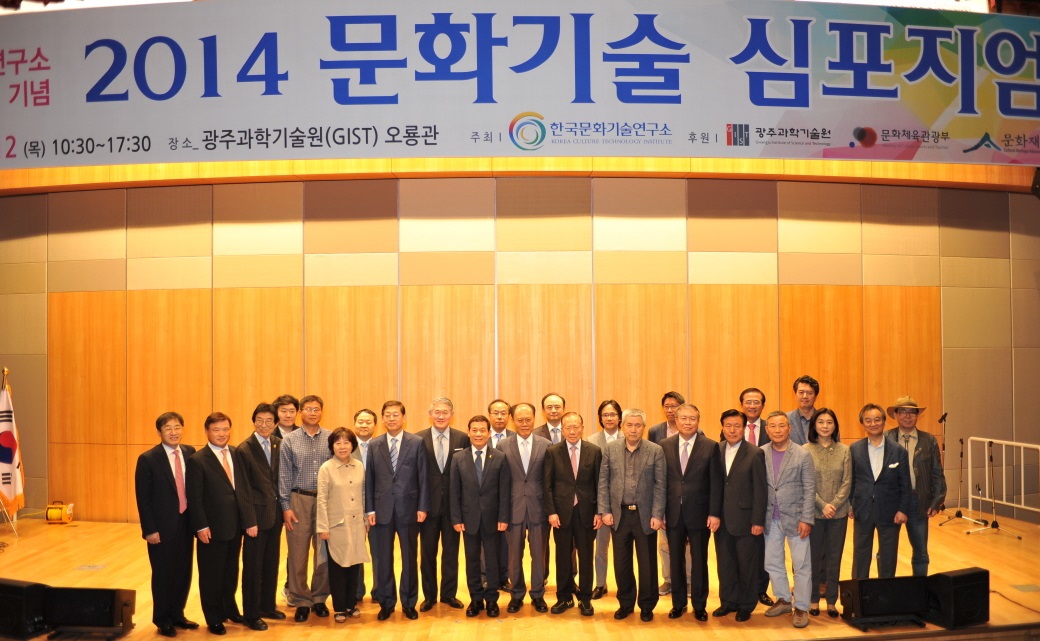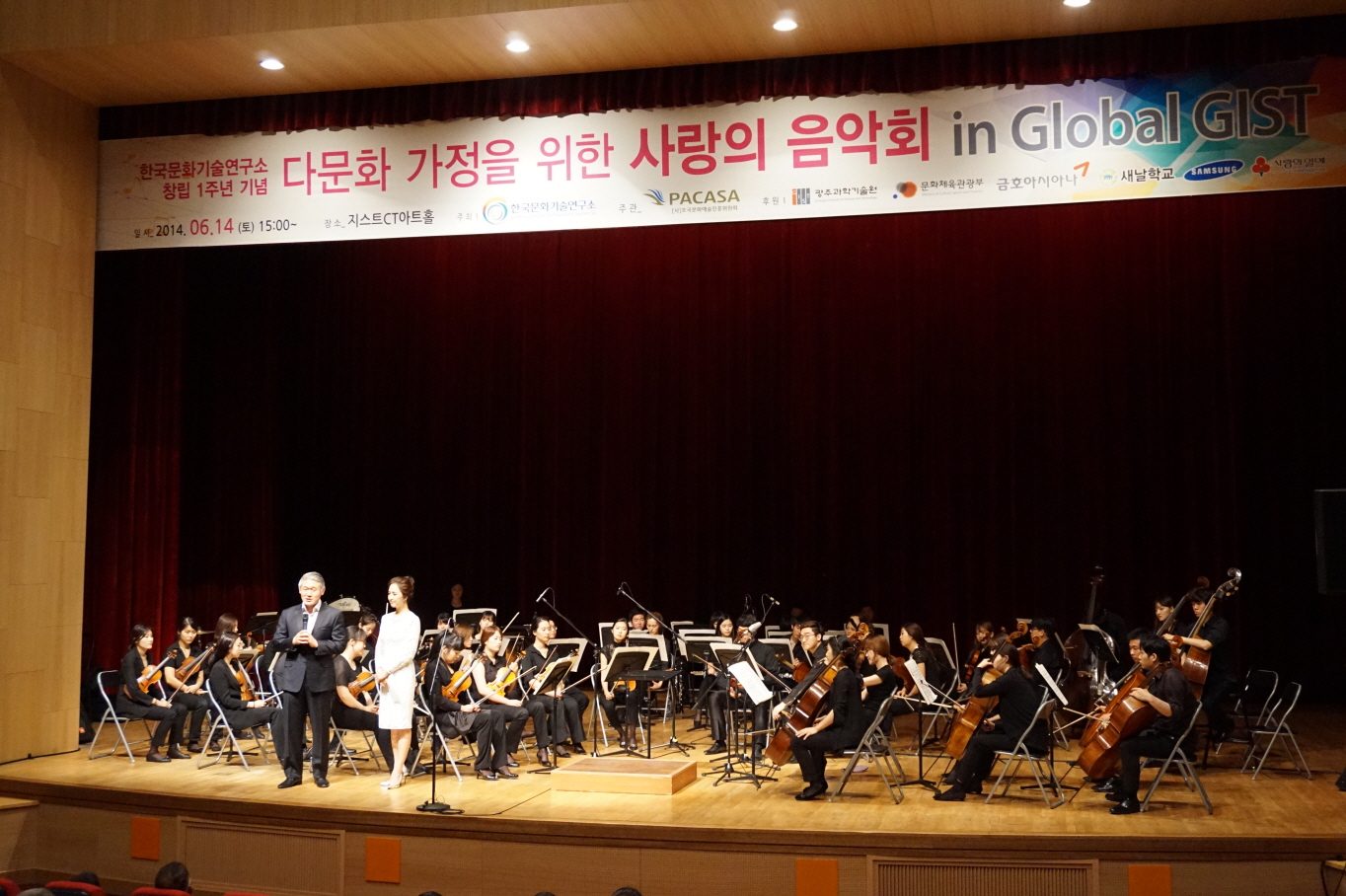Media Center
A multimedia mosaic of moments at GIST
GIST Excellence
Korea Culture Technology Institute Celebrates First Anniversary
- 염희라
- REG_DATE : 2014.07.02
- HIT : 1004
□ 2014 Culture Technology Symposium - Korea Culture Technology Institute (KCTI; Director Jung, Jin Hong), which was established last year for the purpose of leading cultural prosperity and creative economy, held a symposium on the occasion of its 1st anniversary. The theme of the symposium was “Human-centered Culture Technology (CT) – consilience and fusion between arts & humanities and science & technology.” - Culture technology (CT) is a concept that combines culture and technology; it refers to various convergence technologies that are used to enhance the value of cultural contents in every stage ranging from planning through distribution. - The symposium was attended by experts representing various sectors of CT. Leading figures of the academic and cultural communities, including Dasan Distinguished Professor Jung, Jin Hong of GIST, who is also Director of KCTI; President Kwon, Young Gull of Hanssem Co. Ltd., who is also Director of Korea Design Strategy Research Institute and former Dean of College of Art of Seoul National University; Administrator Rha, Sun-hwa of Cultural Heritage Administration; Dean Dongman Lee of KAIST Graduate School of Culture Technology; Director Lee, Jin-woo of POSTECH Humanities Imagination Technology Institute; and Professor Chung, Kyung-won of Industrial Design Department of KAIST, made presentations suggesting new directions for the development of CT. - In addition, experts in the fields of design, architecture, IT, digital health concierge, traditional wood craftsmanship, digital restoration of cultural heritage, media art and digital humanities exchanged opinions during in-depth discussions. Among the participants were Professor Lee, Moo-yong of Graduate School of Culture at Chonnam National University; Mr. Ha, Tae-seok, architect and CEO of SCALe; Vice President Ahn, Mi-jeong of Intellectual Discovery Inc.; Technical Director Yu, Seok-yong of the musical Ghost; Mr. Cho, Ki-jong, traditional cabinetmaker designated as Intangible Cultural Heritage; Director Park, Jin-ho of Eurasia Digital Cultural Heritage Research Institute; Professor Yu, Jin-sang of Intermedia Art Department at Kaywon University of Art and Design; and Professor Yu, Dong-hwan of Cultural Contents Department at Konkuk University - “The purpose of this symposium is to establish an extended ecosystem of the cultural industry that goes beyond the traditional concept of CT,” said Director Jung, Jin Hong of KCTI. As such, the symposium provided opportunities to discuss a broader CT based on life, tradition, and the humanities, which goes beyond CT based on IT, and share views on “humans, culture, and culture technology.” - In particular, the symposium carried significance in the following aspects: that a large number of leading experts representative of various sectors in CT attended, that CT was reviewed from a broader perspective of culture in general, rather than as something unilaterally driven by technology, and that practical examples of applying CT to various areas in life were shared. - The 2014 Culture Technology Symposium was held in two parts. ▲ In Part 1, President Kwon, Young Gull of Hanssem Co. (former Dean of SNU Art College) and Director Jung, Jin Hong of KCTI made keynote speeches. - In his speech, President Kwon presented “My National Design Strategy” to make Korea a cultural powerhouse. He suggested a system to establish cooperation networks encompassing all sectors of culture and arts in preparation for accelerated convergence of those sectors through CT; he also proposed smart urbanism to provide information combining contents and locations of cities. - Director Jung proposed the concept and future direction of CT as a holistic technology to improve the quality of cultural life by combining knowledge and knowhow in arts & humanities, science & technology, and design, under the theme of “humans, culture, and culture technology.” In particular, he suggested that application of CT based on life, IT, and tradition can help realize cultural prosperity and creative economy. ▲ In Part 2, presentations were made in four sessions: Life-based CT, IT-based CT, Tradition-based CT, and Humanities and CT. - In the Life-based CT session, under the premise that all culture technologies exist for life, Professor Chung, Kyung-won of KAIST, Architect Ha, Tae-seok, and Professor Lee, Moo-yong of Chonnam National University made presentations on the development of culture technologies based on life such as design, architecture, and local culture to establish a cultural ecosystem and enhance the value of CT. - In the IT-based CT session, Dean Dongman Lee of KAIST GSCT proposed that Korea as a global leader in IT should move beyond mere contents technology towards a human-centered fusion between culture and technology. Vice President Ahn, Mi-jeong of Intellectual Discovery Inc. and Technical Director Yu, Seok-yong of the musical Ghost also made presentations on “Maintaining Health and Enhancing Quality of Life through Health Concierge” and the “CT Used in Ghost and the Progress of Performing Arts Driven by CT,” respectively. - In the Tradition-based CT session, Administrator Rha, Sun-hwa of Cultural Heritage Administration proposed that Korea should develop traditional cultural contents by combining its ancient relics, historic sites, and CT and then promote them globally. Mr. Cho, Ki-jong, known as the best traditional cabinetmaker in Korea (Intangible Cultural Heritage No. 13), explained some traditional woodcraft techniques. Director Park, Jin-ho of Eurasia Digital Cultural Heritage Research Institute explained a project to digitize traditional cultural heritages including Namdaemun (South Gate in Seoul) and Seokguram (Buddhist grotto in Gyeongju). - In the Humanities & CT session, Director Lee, Jin-woo of POSTECH HiT Institute emphasized that in order for digital technology and humanities to develop harmoniously, human imagination and self-reflection are necessary. Professor Yu, Jin-sang of Kaywon University of Art and Design stressed that CT should be applied not only to commercial popular culture but also to other areas of culture, especially traditional arts, and that CT issues should be dealt with from a cultural perspective rather than an engineering perspective. Professor Yu, Dong-hwan of Konkuk University also stressed the importance of CT that goes beyond a mere physical encounter between culture and technology and reaches an understanding of human being; he predicted CT will draw even more attention as different fields of study continue to converge. □ UHD Gallery - National treasures were shown on ultra-large UHD TV screens at the lobby of Oryong Hall in GIST from June 12 to June 14. This exhibition of cultural assets through three ultra-large UHD TV screens (85-inch each) was planned as part of the Digital Heritage Project and held in parallel with the symposium on the occasion of the 1st anniversary of Korea Culture Technology Institute. - UHD technology captured the mysterious color and intricate inlay of Goryeo celadon porcelains owned by Gangjin Celadon Museum so vividly that viewers felt like they were looking at the Goryeo celadon right in front of their eyes. - Hwangnyongsa Temple and its 9-story wooden pagoda, which now exist only in the ancient book of the Chronicles of the Three States, have also been restored as digital forms so that people can now see the 9-story wooden pagoda and the Buddha’s statue (Jangyookjonsang) of Hwangnyongsa Temple, which were said to be among the top three national treasures during the Shilla Dynasty. In particular, the colors of the digitally restored main temple are so clear and vivid that viewers feel like they just set foot inside Hwangnyongsa, going back 1,400 years in time. - Also on display were the 3D contents of Seokguram Grotto; media artist Lee, Yi-nam’s digitalized works of Vincent van Gogh’s “Starry Night”; and a painting work of mountains and waters by Wang Shizhen, a famous Chinese painter during the Ming Dynasty in the 16th century, which is owned by National Palace Museum in Taiwan. - The 3D contents of Seokguram Grotto were exhibited also at the Metropolitan Museum of Art in New York last year, but only on a single 85-inch UHD TV screen. In contrast, the UHD gallery for the 1st anniversary of KCTI showcased the same contents on three 85-inch UHD TV screens. - “We wanted to show the ‘old future’ of culture technology by restoring Goryeo celadon, Hwangnyongsa Temple, and Seokguran Grotto, which are representative cultural heritages of the Korean people, as UHD contents,” said Director Jung, who planned the UHD gallery as part of KCTI’s 1st anniversary celebration. □ Music Concert at Global GIST for Multicultural Families - A music concert for multicultural families took place at Global GIST on the occasion of the 1st anniversary of its Korea Culture Technology Institute. - The concert was sponsored by Samsung Group through the Community Chest of Korea and was held at GIST CT Art Hall at 3 pm on June 14. - The purpose of this concert was to promote harmony through music among people of different races in Korea, where there are more than 500,000 marriage immigrants, naturalized citizens, and their children (1% of Korea’s total population). - It is even more meaningful that this multicultural concert took place in Global GIST given the fact that approximately 10% of students enrolled in its graduate programs are foreigners. - Director Jung of KCTI explained the purpose of the concert by saying, “We hope people will build bonds and have fun together in the concert so that they realize the difference among races is not a reason for bias and prejudice but rather a foundation of values for mutual respect and living in harmony.” - The concert featured Korean Youth Symphony (KYS) led by conductor Bae, Jong-hoon. Mr. Bae had served as the chief conductor of the National Military Symphony Orchestra for three years before organizing KYS with a group of talented young musicians. - Also featured were tenor Park, Hyun-joon and soprano Han, Kyoung-mee as soloist. Mr. Park won a number of awards at prestigious music competitions in Europe and currently serves as the head of Hangang Opera Company. Ms. Han studied opera at Hochschule für Musik Hans Eisler Berlin and graduated summa cum laude. She has also won a number of awards at major music competitions and is currently the main singer of Fujiwara Opera Company in Japan. - They played upbeat, cheerful music including the Prelude to Mozart’s opera, The Marriage of Figaro, and the concert lasted two hours including an intermission. KBS announcer-turned freelance MC Lee, Ji-ae added to the elegance of the concert. □ MOU Signing with Cultural Heritage Administration - On June 12, Cultural Heritage Administration (Administrator Rha, Sun-hwa) and KCTI signed an MOU for the development new cultural contents through the encounter between cultural heritages and cutting-edge technologies. - The two institutions intend to rediscover the value of Korea’s cultural heritages through the convergence between cultural assets and digital technologies. Under the MOU, they will develop and disseminate high-quality cultural contents taking advantage of CT, thereby contributing to cultural prosperity and creative economy. - They will jointly carry out the Seowon (traditional Korean academy) Renaissance Project, which includes the development of a “digital seowon app,” and other projects to cultivate intangible cultural heriatges into global premium brands; they will also research ways to restore and utilize major cultural heritages through digitization. In addition, the two institutions agreed to work together on ODA (Official Development Assistance) to digitalize major cultural heritages in developing countries. ※ Official Development Assistance is a program under which the governments or state-run institutions of advanced countries provide developing countries or international organizations with foreign aids to help socioeconomic development and enhance welfare.

